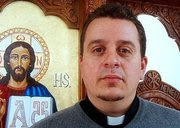In October 948 the Greek Catholic Church in Romania, which is in union with Rome, but which follows the Byzantine rite, was forcibly suppressed by the Romanian Communist government. Its churches were confiscated and converted to Orthodox use.
All the Greek Catholic bishops were arrested - five died in prison whilst the sixth spent the next twenty two years in prison before he died, still in detention. Priests were also often imprisoned, and so the Church went underground, the Liturgy being celebrated in secret whenever possible.
When in 1990 President Caucesceu and his wife were killed and the Communist government overturned, the Greek Catholic Church regained its freedom, but not its churches, which remained in Orthodox hands.
In 1991 an ecumenical group from Rothwell had travelled to Romania to visit the
orphanages and deliver food and clothing. As a result of this visit two years later a
Romanian, Doctor Aurel Rusu, visited Rothwell and it turned out that he was a Greek
Catholic,who himself had been imprisoned for four years under the Communists.
In the year 2000, Doctor Rusu and a young Greek Catholic priest accompanied ten young Romanian musicians to Sowerby Bridge where they stayed with Catholic families for two weeks, during which time they played in six venues in the diocese. Father Lucian Dudas was the young priest. Ordained less than one year, he had been given charge of a village in Transylvania, called Ungheni. The villagers had originally all been Greek Catholics, but the church was still in Orthodox hands. Fr Lucian had a small congregation who met to celebrate the Liturgy in a small disused classroom in the grounds of the local school. In 2001 he had obtained a plot of land and had plans to build a church.
Over the next seven years some Catholic parishes in the Leeds diocese helped to fund the building of this church. So on September 3rd four people from Sowerby Bridge, Horsforth and Knottingley travelled with Mgr Sharp and Sister Damian C.P. for the consecration of the newly completed church.
The ceremony commenced at 9.30 a.m. on Sunday morning with the Patriarch, Archbishop Lucian being met by children in national costume offering him bread and flowers. The ceremony of consecrating the church by anointing the walls of the church, both outside and in followed. After this, because there were four hundred people attending from different parts of the diocese, the Liturgy was celebrated outside the church. It was 1.30 p.m. when the Mass in the Byzantine rite finished! It was with some relief that we all, three hundred of us, retired to the village hall for a meal.
In addition to taking part in the Liturgy on the Sunday, we were able to visit other places. On one day we visited the salt mines in Praid. Onboard a rather ancient bus, we travelled into the side of a mountain for about a quarter of a mile and then descended nearly two hundred steps into a vast cavern, which had been carved out of salt, with its own chapel, swings and toys for children and a café.
A visit to Transylvania could not go by without a trip to Sighisoara, where on our final day we had lunch in the house where Dracula was born and raised. To the Romanians he is not the Bram Stoker figure of horror, but a national hero. But the real heroes for us were the Greek Catholics Church members who underwent and survived tremendous persecution during the second half of the twentieth century. The consecration of the new church at Unghem is a sign that after apparent death, can come new life.



Niciun comentariu:
Trimiteți un comentariu